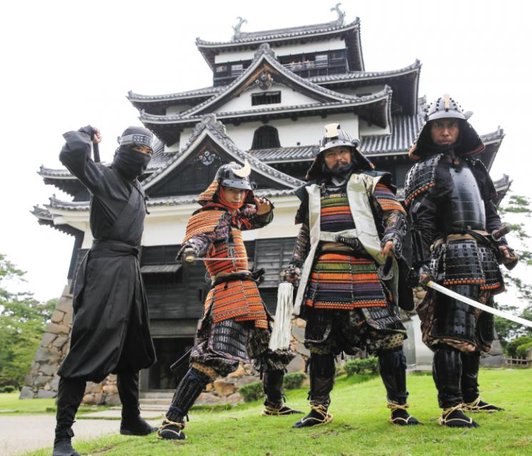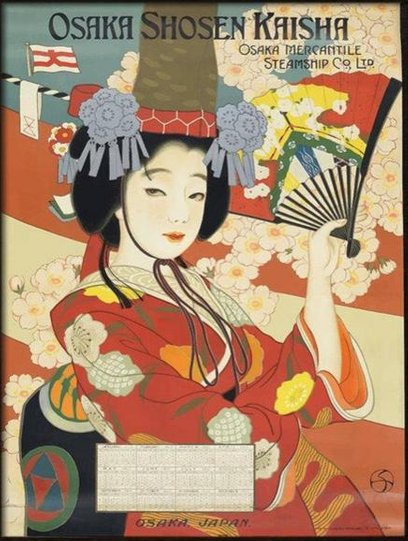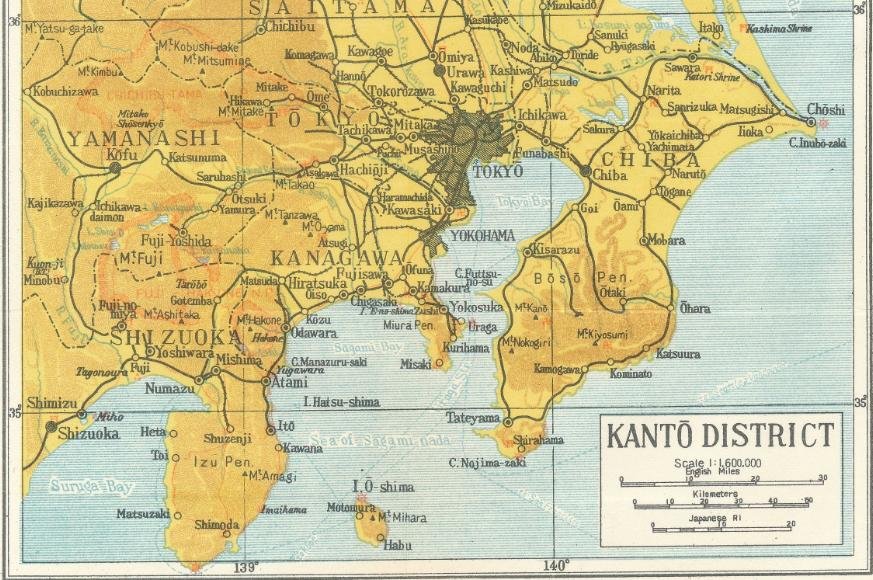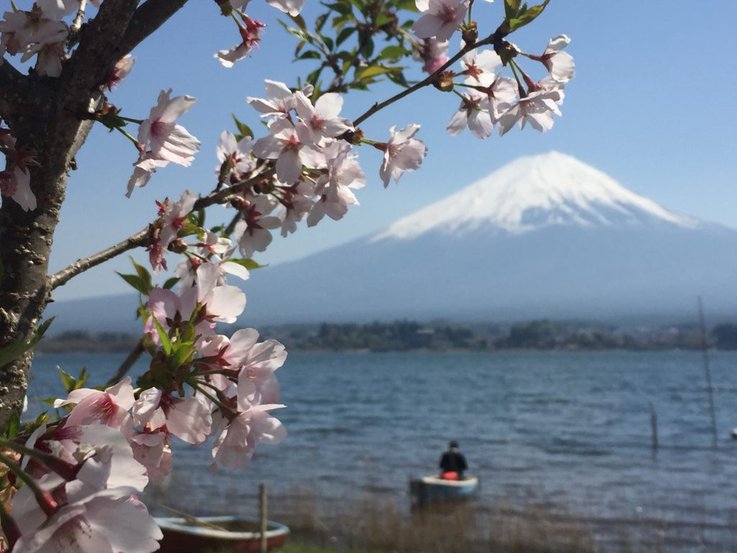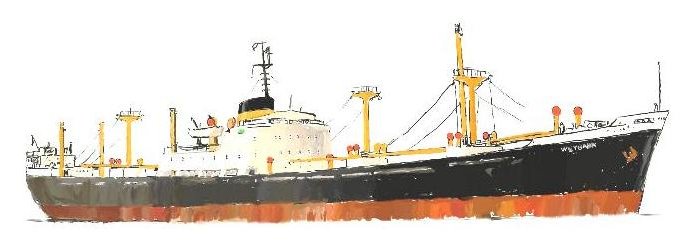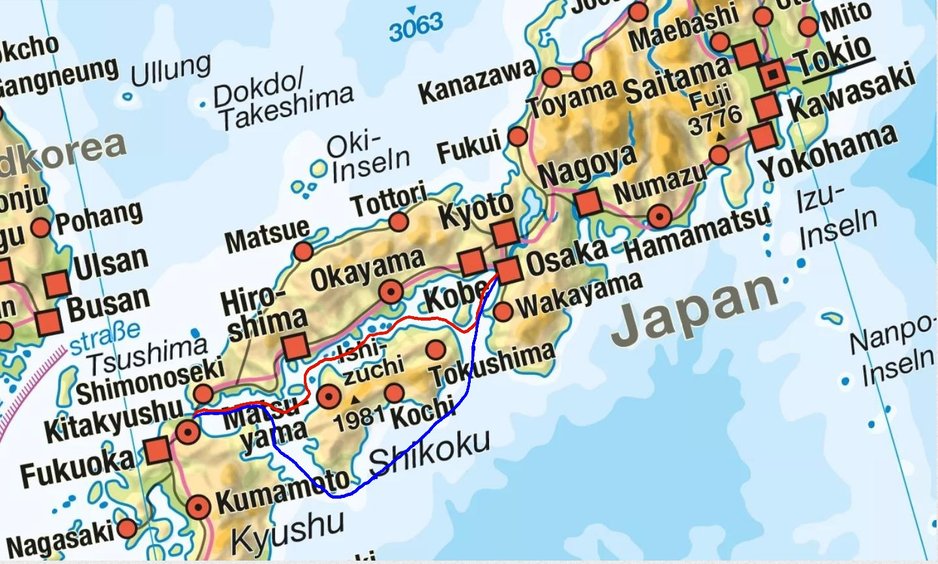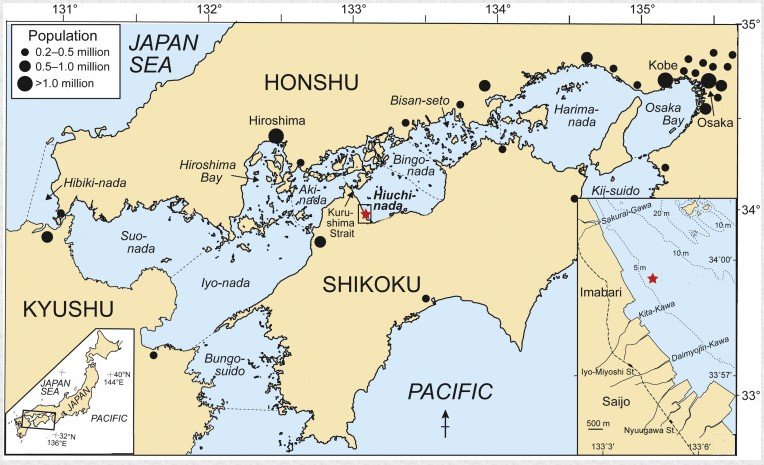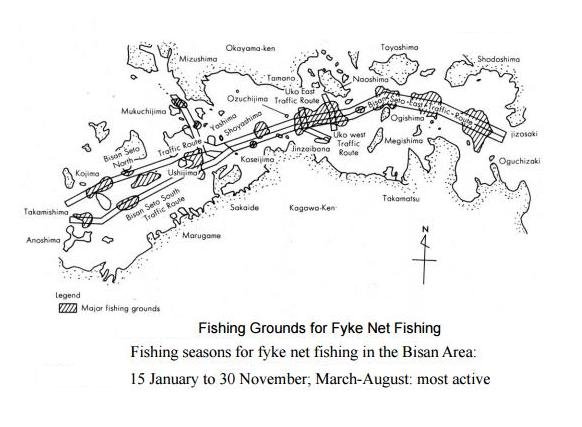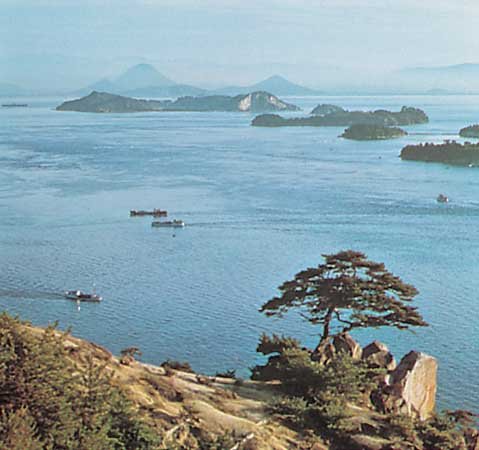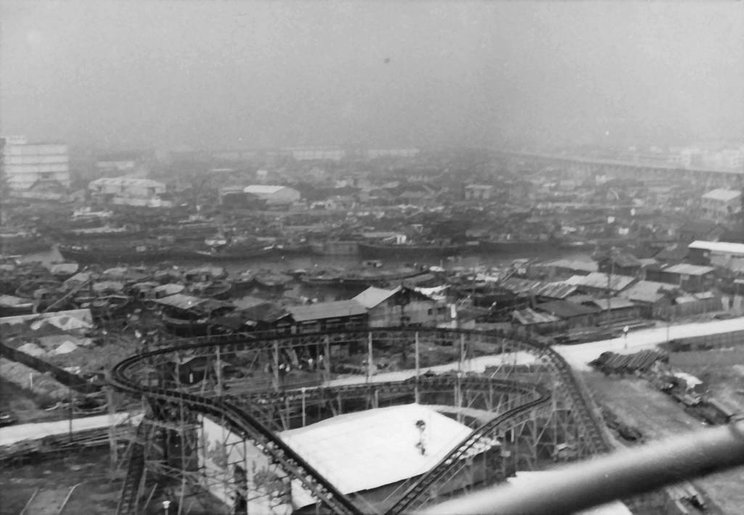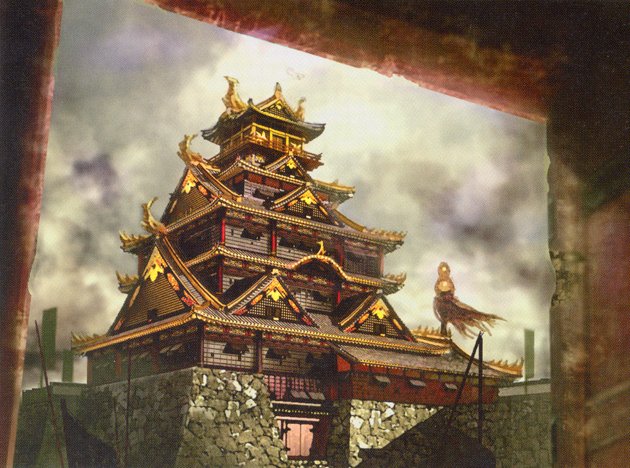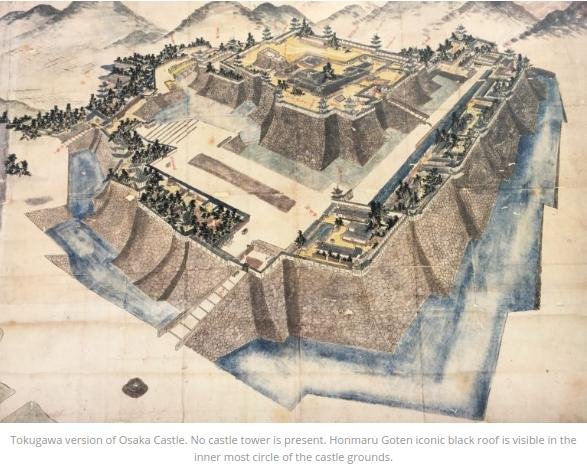Mandalay
By the end of the Edo period, things were looking bad for the Tokugawa government. After years of strife and political conflict, the last Tokugawa Shogun, Yoshinoba dissloved the Shogunate which enabled the Imperial court to seize power (but not without a war between Tokugawa loyalists and Imperial forces - the Boshin War).
After the Meiji Era, Osaka Castle became the property of the Japanese military and the castle eventually came to house what was probably the largest weapons factory in East Asia. The factory produced everything from guns to cannons and was the principle reason Osaka became a target during WWII.
In 1931 a reconstruction effort was completed which also included a replica of Hideyoshi's palace on top of the stone wall left from the Tokogawa period. Osaka fire bombings in WWII destroyed much of the city but despite the air raids the palace main tower survived and stands to this day, as shown below.
There are more such castles each with a similar architecture scattered at various locations throughout Japan. For any other Samurai fans out there here are the names of seven of them:
Matsumoto, Gifu, Hirosaki, Matsue, Inuyama, Hikone and Himeji. If you Google any of these names followed by „Palace“ you will be able to view a lot of impressive photos of them and find their locations. A parting shot of Matsue Castle:
The Weybank did not sail to Kobe but the next morning I ended up there anyway. As far as I can remember I took some Lascar crew members to a clinic there. I often got such jobs when in port as I had more or less nothing much else to do unless I thought up something myself, like Osaka Castle.
We were driven the 30 km there and back through rain and sleet and all I remember was that I didn‘t realise that we were in Kobe when we arrived there. The two cities had grown into each other along the coast.
That same afternoon back aboard the Weybank in Osaka , Malcom the 3rd Eng asked me if I would accompany him ashore for a look around. Why not? „Ready when you are Mr. Pembry „ (quote from Hannibal Lecter in „Silence of the Lambs“ to his prison cage guard just before he strung him up).
Off we trundled into the unknown. We first ended up in of all places a Japanese cinema which advertised a movie we wanted to see which was in English with Japanese subtitles (or was it the other way around?). It was a weird kind of cinema because the seat rows were wide and instead of cinema seats there were couches and little tables and to top it all off the usherettes also doubled as waitresses plying us with Japanese beer and munchies such as dried squid (which tastes good with a beer and prevents you getting blotto). Unfortunately none of them could speak English (the girls, not the squid) so there wasn‘t much chance of a „close encounter“. When the movie ended we said our „Sayonaras“ and stumbled back out into the street. Malcom then out of the blue said that he had
to find a Japanese Pawn Shop (yes, Pawn not Porn). „Did I hear right, a Pawn Shop? Did you learn Japanese overnight? How the hell can we ask a Japanese for Pawn shop directions? If we were in dire need of a Parisien type pissoir we could possibly mimic our distress by dancing around holding our crotches while exclaiming „toyrettu“ but „pawn“? What do you need a Pawn shop for anyway?“.
He unzipped his coat and spread his wings in „dirty old man“ fashion. His coat inside pockets were lined with Bank Line silver – not coins like in Treasure Island‘s „three pieces of silver“ but knives, forks, spoons and ladles. „Got more in here“ he said proudly, patting one of his outside pockets.
I thought I had seen it all but apparently not. „Are you f…… crazy or just retarded? You keep those on you. When we get back aboard we will no doubt hear how they all had to eat dinner like Lawrence of Arabia in a black tent. It‘s your problem how you get your booty back where it belongs. I hope they catch you. I need a f…… drink!“. Off I strode heading for the nearest bar that came my way. In I marched but came to an abrupt halt when I saw directly to the left three lovely Japanese girls sitting at a round table. They all jumped up making „Aiee!“ sounds and one of them said „you come sit here!“. I didn‘t need to be told twice. Malcom who had been following me at a respectable „hope he cools down“ distance peeked through the door.
„Osakako“
It felt like a „deja vu“ of Moji, the two other girls spoke passable Japinglish whereas the one that told me to sit down was pretty fluent. We were soon having a merry time together after a couple of rounds. During the conversation the „fluent“ one, who I‘ll name „Osakako“, pointed at her nose and asked me what I thought of it, if I liked it? I thought that this was some kind of „you fell for it“ trap but said instead „I think it‘s very sweet, can I kiss it?“ or some such Schmalz. To my surprise she answered „No, no, no understand! I have plastic surgery! Make nose straight like movie star, you like? Soon make bosom new too!“. This was in 1969 and I had never heard of (what is now commonplace) cosmetic plastic surgery. Maybe in 1969 it was also becoming popular in the UK but we at sea were clueless if it was. I asked her if the surgery was painful and what it cost – she tried to explain in Yen but we got lost but not before I understood that it was expensive. I wondered what drove a bar girl who couldn‘t be making a load of money, not even if she was making some on the side in the oldest profession, to save her every Yen for such a cause.
The bar room width was average but its length was substantialy longer. Since we had arrived all the other tables were empty and apart from us and the girls there were only four or five Japanese men in the distance sitting with their backs to us at the bar. When Japanese is spoken it sounds relatively monotone and when the men talk with each other it sounds to our ears as if they are constantly argueing.
When the girls and we were laughing a lot I had kept an eye on the bar-proppers. They seemed to be getting louder by the minute. One of them then swivelled around on his bar stool and started shouting at us in Japanese. Osakako started to shout back. I asked her what was wrong but she said „no, no, just sit“. Then the other barflies swivelled around as well and joined in the harangue. Osakako and one of the other girls gave back as good as they got. That definitely got on warlord Tokugawa‘s wick. Jumping off his barstool for imminent Kendo sword practice with the two „long nose“ dummies, he gave a good impression of „Godzilla“.
Osakako then said to me „better go now“. I asked if she would be ok and she said „yes, no problem but you must go now“. A look in her eyes said it all. Japanese women had been through the centuries generally treated as inferiors by their menfolk, good for only two things but their menfolks‘ indifference would suddenly evaporate if they felt that they had lost control.
Reluctantly we said goodbye to our gracious hosts and exited the bar into the cold and wet evening.
I kept glancing over my shoulder expecting the nutcases to come tearing out of the bar after us.
The Japanese barflies were all at least double my age and all wore the standard black leather
jacket. They could all have been Japanese Mafia „Yakuza“, or just simply middle aged black-jacket trend setters.
From the Japanese youth around my own age I seldom noticed any animosity but this was not the case with many of the Japanese men who had experienced the war, especially the ones who had been soldiers of the Emperor. Many of these men had reluctantly layed down their arms, only after being ordered to do so by Emperor Hirohito.
That night aboard the Weybank Malcom sneaked into the dining salon and replaced the silver into empty drawers. The chief steward had locked the silver away (that Malcolm had left behind him) in some hidden place for safe keeping overnight. I enjoyed breakfast next morning – talk of ghost Ninjas!
That same morning we sailed for Yokohama – 362 sm, 24 hours sailing time
Yokohama
Yokohama which is more or less Tokyo‘s port city lies in Tokyo Bay just about 10 km south of Tokyo. Today it has a population of around 3.8 million, the second largest in Japan after Tokyo.
During the feudal Edo Tokugawa shogunate with it‘s „no foreigners“ seclusion policy, Yokohama was just a small fishing village. A major turning point in Japanese history occured in 1853–54 when US Navy Commodore Mathhew Perry arrived just south of Yokohama with a fleet of American warships, demanding that Japan open several ports for commerce, otherwise they would blow the sh.. out of Yokohama. The Tokugawa shogunate reluctantly acceded to signing the cynicaly named Treaty of Peace and Amity that was shoved up their noses.
It was finaly agreed that one of the ports to be opened to foreign ships would be the sleepy fishing village of Yokohama and thus the Port of Yokohama was officially opened on June 2, 1859.
Much of Yokohama was destroyed on September 1, 1923 by the Great Kanto Earthquake. The Yokohama police reported casualties at 30,771 dead and 47,908 injured, out of a pre-earthquake population of 434,170.
Yokohama was rebuilt, only to be destroyed again by U.S. air raids during World War II. An estimated seven or eight thousand people were killed in a single morning on May 29, 1945 in what is now known as the Great Yokohama Air Raid, when US B29 bombers firebombed the city and in just one hour and nine minutes reduced 42% of it to rubble.
During the American occupation, Yokohama was a major transshipment base for American supplies and personnel, especially during the Korean war. After the occupation, most local U.S. naval activity moved from Yokohama to an American base in nearby Yokosuka.
In 1969 with the Vietnam war running in top gear, the US military in Japan was omnipresent, being used as a logistics base and where they built military hospitals to treat the severely wounded Vietnam GIs and Marines where they were patched up before being able to be transported further back to „the world“. Yokohama was also one of their favourite R&R locations (Rest & Recreation or Recuperation was for a GI a 5-day „mid-term“ war vacation (unless you were a married officer – they got a bit longer so that they could visit their wives in Hawaii). The Japanese in cities with a strong US presence had long ago figured out how to lighten a GI‘s pockets. In towns and cities with nearby US bases, Suzy Wong type girlie bars popped up everywhere, as did their prices for „services rendered“ - geared to the US dollar economy. Bad news for poor sailors like us but good news for our health.
However, we only stayed in Yokohama for a day so I can‘t say much more about it.
We departed Yokohama early next morning as the sun was rising above the horizon. Until then I had been able to get only an occasional glimpse of Mount Fuji‘s snow covered crest through the gloom. This was the only day in all our time in Japan when the sun wasn’t hidden behind the murk of snow clouds.
Mount Fuji is an active volcano situated about 100 kilometers west of Yokohama. Commonly called “Fuji-san,” by the Japanese (and now also officialy by the UN Heritage) it is the country’s tallest peak, at 3,776 meters. A pilgrimage site for centuries, it is also one of Japan’s three sacred mountains.
As we sailed out of Tokyo bay through the Iraga Strait we could see Fuji-San in all her glory from across Sagami Bay. It was a beautiful sight with the rising sun changing the colour of her snow covered crest in hues of pink and gold and remains fixed in my memory to this day. It felt as though Mojiko was bidding me Sayonara.
„But, you cannot stay till morning, for your sailing with the dawning,
And when midnight sounds its warning, say, “Oyasuminasai.”
And the cold, grey light will find you, as Mount Fuji falls behind you,
With just one word to remind you, “Sayonara” means goodbye“.
M.V. Weybank - Chapter 12
Japan: Osaka - Kobe - Yokohama
The Inland Sea (Setonaikai) lies between the Japanese main islands of Honshu, Shikoku and Kyushu. Its mainly calm waters stretch over 400 kilometers from Osaka to Kitakyushu and include over 800 islands, many of which are inhabited. This not counting around 2000 more which are either tiny or just submerged below the waterline. The Inland Sea's mild climate in summer invites comparisons with the Mediterranean Sea. It is a vital shipping lane and is covered by an extensive ferry network, as many of the islands are connected to one another by small local ferries.
As the crow flies it is 419 km or 226 sm from Kitakyushu/Moji to Osaka. If the crow flew at a speed of 15 kts it would take it 15 hours flying time. If we took the Inland Sea route (traced in red above) we would have to keep changing course to avoid bumping into one or more of the islands sprinkled throughout the sea. However, if we could maintain our speed of 15 kts we would be able to cover our non-crow sailing route of around 240 sm in about 16 hours, if it were not for….
The map above shows the Inland Sea‘s major islands. The suffix „nada“ translates as „open sea“ as for instance Suo-nada and implies that they are areas with relatively fewer islands. The sea has more than a few bottle-necks, the Kurushima Strait being one of them – shown in both maps, in the one below at Imabari. Note the little green flecks which are also islands.
Even in summertime the Inland Sea due to its islands and ferries is not exactly a walk in the park to navigate. In the summer months of May, June and July, fog frequently occurs which can last at least half a day or more before lifting. In Osaka Bay fog frequently occurs also in wintertime. In summer or winter there are also fishing boats to contend with. There are 18 or more different fishing methods employed by the Japanese depending on which type of fish they are fishing for. Amongst these are Fyke net fishing (a fyke is a type of fish trap). The diagram below shows the Fyke net fishing grounds of the Seto Inland Sea – smack in the middle of the ship traffic routes!
In spring for instance, there is Japanese mackerel (sawara), in summer, butterfish (managatsuo), in autumn, black sea bream (chinu, kurodai) and in winter, young yellow tail (hamachi, buri). A great variety of seasonal seafood is caught throughout the year. In 1999 the fish catch per unit area per year of 20.6 ton/km/year in the Seto Inland Sea was the largest in the world (due to nutrients from land which are well mixed and efficiently recycled by the many straits in the sea).
In wintertime it becomes downright dangerous. I don‘t know how the Japanese maritime regulations were in 1969 but I do know that by at least by 2002 it was mandatory for ships above 10000 tdw to carry a Japanese pilot when navigating the Seto Sea.
Casting off from Moji in the early evening, we have a Japanese pilot aboard. The weather is our worst enemy as it has not changed since we arrived at Moji and indeed it will not change until the day when we depart Yokohama and Japan – in brilliant sunshine! We sail into the Inland Sea but we are not going to traverse it all the way to Osaka, instead we will sail east through the Suo-nada but then turn southwards through the Iyo-nada and Bungo-suido (water-gap) until we reach the southern tip of Shikoku at Okinashima Island and then turn northeastwards along the Shikoku coast heading for Wakayama Bay, which we will eventually pass through into Osaka Bay. On our way along the Shikoku coast we have to keep a sharp lookout for fishing boats as the waters along the coast are heavily fished fishing grounds.
Taking this route is commonsense. The good thing about it (apart from the risk of collision if we had taken the traverse route) is that we can thump along at our 15 kt speed most of the way (which we could not do in the Seto Sea as there are speed limits set for various areas e.g. 12 kts), taking us just 24 hours or so to reach Osaka. We have to cover 362 sm (671 km) instead of 240 sm with the transverse route and will expend more fuel but takes out of the equation the nightmare of our Japanese ship-agent phoning up the Bank Line HQ: „Velly solly but Weybank misfoltune Kulushima Strait, hit numba-10 felly from Omishima. Weybank now undelwotel but all crew pull out suido safe. Captain commit Hara-kiri later, Seppuku style. Japan officials want know who pay unblock Kulushima Strait – big ploblem!“
It was a great pity that it was not summertime when we might have seen the beauty of the Seto Sea with our own eyes such as the shot of it taken below from Okayama (see the top map for location).
Or the following shot from the 1980 TV series „Shogun“ with the Inland Sea background (starring the lovely Yoko Shimada as Mariko and ladies heartthrob Richard Chamberlain as pilot „Anjin-san“ John Blackthorne – Chamberlain, like Rock Hudson before him „came out“ a few years later).
Back to the real world. Below is a 1960‘s photo of Osaka port (shot from the tower of a Helter-Skelter rollercoaster). When we arrived it was just as dismal looking but covered with snow. By 1969 however it had changed a lot, mainly (in my mind‘s eye) by the construction of white multi-storied appartments and office buildings and highways just about everywhere you looked as Osaka prepared for the upcoming Expo '70 World Fair.
Stretching along Osaka Bay and crisscrossed by rivers and canals, Osaka is known as the “city of water” and has a population of over 2.6 million. The city of Kobe (1.5 million) lies about 30 km to the west.
Similar to when I was in Hong Kong and had a lot of time in my hands, I asked our Osaka shipping-agent how to get to Osaka Castle – no sooner said than done! As a youth I had been intrigued by stories of Samurai and Ninjas in which Osaka Castle was frequently the centre of the action.
From 1603 to 1868 (the Edo Period) Japan was a feudal society with a hierarchy of lords, samurai, and peasants, ruled for nearly 260 years by the Tokugawa Shogunate. It was within this period that Japan isolated itself from the rest of the world leaving just a back door open to trade with Korea and China. In 1867 however, the 15th Tokugawa Shogun resigned, and by 1868, the Meiji Restoration had begun.
The Meiji Restoration was a revolution in 1868 that brought about the final demise of the Tokugawa Shogunate (military government) —thus ending the Edo period and, at least nominally, returned control of the country to direct imperial rule under Emperor Mutsuhito (who then took the name
Meiji). The Emperor moved to Edo, which was renamed Tokyo thus Tokyo became the capital of Japan.
Osaka Castle
Warlord Toyotomi Hideyoshi, after he had successfully conquered Japan in 1583, built the first Osaka Castle on the Uemachi Plateau which itself was surrounded by several rivers making it a difficult stronghold to attack. After Hideyoshi's death the castle was attacked by another warlord, Tokugawa Ieyasu, who set the castle ablaze burning it to the ground while Hideyori (Hideyoshi's son) and his mother inside committed Hara-Kiri rather than surrender.
Hideyoshi‘s palace tower‘s predominantly black walls with gold fittings gave it, no doubt intentionally, a sinister threatening aura.
After Tokugawa became Shogun (miltary leader of all Japan and the first of the Tokugawa Shoguns) he gave his own son Hidetada the task of building a new castle, once the smoke cleared, on top of the ashes of Hideyoshi's once grand castle. Ten years later it was completed in 1629.
Thirty one years later in 1660 there was a massive explosion when lightning struck the gun powder storage room which blew the castle tower to pieces and burned down many of the castle's other structures.
After the explosion, the castle's main tower was not rebuilt until nearly 300 years later. Instead a large building called Honmaru Goten was built near where the castle tower had stood.

